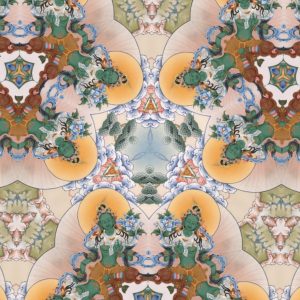from “
The Copper-Colored Mountain: Jigme Lingpa on Rebirth in Padmasambhava’s Pure Land” Chapter 3. “
The Three Levels of the Lotus-Light Palace” herein subsections from commentary on “
Stanza 10: The Nine Vehicles”
Expounding on “Outline of the Nine Views“
The Three Outer Vehicles
The spiritual journey of Buddhism starts with the vehicle of the sravakas, the so-called hearers, who heard the teachings of Buddha Sakyamuni. According to the commentary of the learned Indian master Vimalamitra, a key figure in transmitting the Great Perfection teaching to Tibet, the view of the hearers is based on realizing our own selflessness but not that of external phenomena, which they maintain are made of indivisible particles. Their meditation is informed by practices that render tranquil, to the point of cessation, the objects of the six sense bases. Monastics observe 250 vows and laypersons cultivate ten virtues for their own spiritual advantage. While this summarizes the conduct of the sravakas, the result of the Foundational Vehicle is the attainment of the exalted state of an arhat, or foe destroyer.
Next is the vehicle of the pratyekabuddhas, or solitary realizers. These sages have discerned the difference between absolute and relative truths, having attained emancipation without guidance from a spiritual teacher. They conceive relative truth as an illusory display of the twelve links of interdependent origination and come to realize, like the hearers, the ultimate truth of individual selflessness. Pratyckabuddhas attain release when they meditate on the emptiness of the twelve links in reverse order. Their conduct is, for the most part, self-serving, with occasional miraculous displays that benefit others. If the solitary realizers decide to teach, they do so by means of their bodies, not by words, and they adopt nonverbal means of communication to give instruction.” In the end, they become solitary sages, a similar state to that of the sravakas.
The last causal vehicle is that of the bodhisattvas, also known as the Great Vehicle or Mahayana. According to Vimalamitra, in the view of bodhisattvas, individuals and phenomena are empty, devoid of an inherent self. In their meditation, they cultivate the union of tranquillity (Skt. samatha) and insight (Skt. vipasyana). This frees them from the obscuring layers of ignorance and yields a nonconceptual state of concentration. By way of conduct, they refrain from committing the ten nonvirtues, while they actively engage in ten kinds of virtue for the benefit of others. They go through ten stages of spiritual development (Skt. bhumi) and attain complete illumination in the union of the two kayas, the dharmakaya and the rupakaya.
According to Mipham, the sravakas, pratyekabuddhas, and bodhisattvas belong to the vehicle of characteristics because they adhere to the doctrine of causality. He explains that this vehicle teaches the truth regarding the “general and specific characteristics of phenomena” and the “characteristics of total affliction and complete purity” by showing what is to be abandoned and what is to be embraced. In other words, the afflictions of relative truth need to be relinquished so that absolute truth can be attained.
The first three causal vehicles belong to the path of renunciation and rely on external characteristics, causality, and the perfection of virtues. By contrast, the vehicles of Vajrayana teach that affliction and total purity are inseparable and unchanging as the mandala of the awakened body, speech, and mind. From the secret viewpoint of Vajrayana, the recognition of absolute truth is integral to the path of training. The convergence of training and its fruit renders unnecessary the explanations of the lower vehicles. This is because the first three vehicles rely on observable phenomena grounded in space-time causality. In effect, the tantric vehicles -also known as the vehicles of the result— rely on the uncaused state of the mind’s intrinsic nature. As aptly expressed in the Gubyagarbha Tantra, Except for this definitive great secret that takes the result as the path, another definitive secret (path) has never existed…. This is the supreme seal of all [tantras].
The Six Vehicles of the Vajra
In his commentary to Padmasambhava’s exposition of the nine vehicles, the Garland of Views, Mipham explains that the Bodhisattva Vehicle-also known as the vehicle of perfections (Skt. paramitayana) — takes its name from its cause. The result of the vehicle of perfections is not different from Vajrayana since both fulfill the aims of Mahayana. “The view of those engaged in the cultivation of the six perfections is to realize that the whole of the total affliction that is samsara, in both cause and result, and of the complete purity that is nirvana, in both cause and result, is completely devoid of inherent or true existence on the ultimate level.” Dudjom Jigdral Yeshe Dorje explains that the meaning of Vajrayana is the indestructible vehicle that takes the mind of the buddhas as the path:
The mind of all Buddhas is indestructible because it is the essence of the nature of phenomena, which cannot be destroyed by any spiritual teaching based upon characteristics (mtshan mar gyur pa’ i chos). Since it is similar to dorjé, the wisdom mind of all Buddhas is called “dorjé” [indivisible and indestructible] and abides as the essence of mantra, as previously explained. The term tekpa, “vehicle,” is used both literally and metaphorically, because it is either the support for the attainment of the mind of all Buddhas, or else the path traversed.
The esoteric teachings grouped under the vehicles of the vajra are subdivided sequentially into three outer tantras and three inner tantras. The first outer tantra is concerned with a variety of ritual activities that lead to personal transformation. The aspirant of the Kriya Tantra Vehicle upholds ritual purity and engages in outer and inner ablutions, reciting mantras, drawing protection circles, displaying mudras, and so on. The Kriya Tantra maintains the performance of rituals with the understanding that all activities are without intrinsic essence. In the Sequence of the Path, it is said that “through discriminating awareness all branches of ritual, according to the tradition of Kriyâtantra, the Sugata made the result into the path.” The meditation of Kriya Tantra consists of viewing oneself as the samaya being, or commitment being (Skt. samayasattva), while visualizing the deity in front of oneself as the wisdom being (Skt. jnanasattva). The conduct entails making offerings to the deity and thereby fulfilling the benefit of self and others by observing the five root and two subsidiary principles laid out in the treatises of this tradition. As a result, one will attain in sixteen, or even seven, lifetimes the state of Vajradhara of the three families.
The second outer tantra is the Carya, less commonly referred to as the Ubhaya Tantra Vehicle. It is also known as the Dual Tantra because it trains one to abide in both the physical and verbal conduct according to the Kriya Tantra while adopting the view of the Yoga Tantra Vehicle. According to Vimalamitra, the meditation of Carya Tantra consists in familiarizing oneself with the four actualities of deity yoga rehearsal —namely, the actuality of oneself as the samaya being, the deity as the wisdom being, the seed syllable at the heart center of both the samaya and wisdom beings, and verbal recitation while discharging and absorbing light rays that issue from oneself and the wisdom being. The result leads to the state of Vajradhara of the four families in seven or five lifetimes. The first two outer vehicles, Kriya and Carya, are also grouped under the path of purification, since their function is to purify latent defilements and habitual false views.
The last of the outer tantras is the Yoga Tantra Vehicle. Its emphasis is not on mere ritual activities of purification but on the integration of external actions with contemplative meditations. The view of this vehicle has two aspects. According to Vimalamitra, the ultimate aspect is to realize the sphere of reality, “naturally pure wisdom,” while the relative aspect is “the result of realizing this ultimate; namely, the assembly of deities of the five families, or of the vajra family.” Meditation consists of visualizing the deity through images and entering the sphere of reality that transcends images. During the practice of deity yoga, the appearance of oneself as the samaya being and the deity as the wisdom being involve the dissolution of the latter into the former. In terms of conduct, one follows the esoteric scriptures of this tradition and abides by the vows of the five buddha families and the consecration of the five aggregates by the five buddha families. As a result, one attains the state of Vajradhara in five or three lifetimes.
For the outer tantras, spiritual realization is attained by invoking, requesting, and serving the wisdom deity, but, for the inner tantras, spiritual attainment is naturally present and spontaneously manifests as the mandala of the deity. In the outer tantras, one maintains a subtle distinction between the two truths (relative and ultimate), deities are not visualized with their consorts, and one cannot attain the result in one lifetime. In contrast, from the perspective of the inner tantras, absolute and relative truths are inseparable and all phenomena are deemed equal from this perspective. Furthermore, the five meats and nectars are tasted, the divinities are visualized in sexual embrace with their consorts, and one can realize the result in this lifetime.
The last three tantras begin with the Mahayoga Vehicle, which contains teachings based on oral transmissions and revealed scriptures. The view of Mahayoga, writes Vimalamitra, is to realize reality as-it is and see all phenomena subsumed under samsara and nirvana as inseparable from ones own enlightened awareness. As stated in the Array of the Path of the Net of Magical Manifestation, a commentary to the main tantra of Mahãyoga (the Gubyagarbha Tantra), “All this appearance is consciousness alone, devoid of inherent self-nature: naturally present, pristine awareness, manifesting with no fixed abode.” In Mahayoga-styled meditation, one perceives all appearances as the mandala of the deity, and, during the completion-stage practices, one rests in the state of reality itself— empty and luminous, devoid of elaborations, and beyond conceptualization. In terms of conduct, one observes three sets of root commitments and twenty-five subsidiary ones and abides in a state free from views and moral judgments. As a result, one attains realization of the five kayas in one lifetime or in the intermediate state, the bardo (Skt. antarabhava).
Next is the Anuyoga Vehicle, also known as Subsequent Yoga because it reveals the path of desire in pursuit of discriminative awareness. The view in this approach is to recognize that all dualistic phenomena in samsara and nirvana are no different than the dynamic energy of the nature of mind— the sphere of the dharmakaya-supreme in all aspects and beyond all contrivance. The meditation includes the spontaneous generation of the deity while engaging with the vital channels (Skt. nadi), energy winds (Skt. prana), and seminal drops (Skt. bindu), which have always been part of the mandala of the deity. The conduct of this approach accords with the precepts of Mahäyoga, and the result is attained in one lifetime.
The inner tantras of Yoga, Mahäyoga, and Anuyoga are grouped under the path of transformation because, during the sadhana practice, the karmic or ordinary winds (that circulate throughout our body and determine our deluded perception of reality) are transformed into wisdom winds. This brings us to the last inner tantra, the Atiyoga Vehicle. Being the ninth and highest vehicle of all Buddhist teachings, it is the path of no-path of the Great Perfection (Dzogchen). For Vimalamitra, the view is to realize that all phenomena arise spontaneously and are pure in their own ineffable emptiness; that is, to see the nonself of both persons and phenomena without needing to grasp a reference point. Practitioners of Atiyoga do not employ focal points or imagery during meditation. Rather, they abide in the innate lucidity of awareness that is naturally free from fixation, “a spontaneous, present, and completely perfect equality, a rootless transparency.” Their conduct is devoid of moral deliberations and calculative actions. As we read in The Ningma School of Tibetan Buddhism, “Other than this there is nothing to be obtained. When everything indeed has been ripened, there is nothing to be reached. This reality is the essence of the path.”
Atiyoga is also known as the vehicle of self-liberation. It is the “king of vehicles,” writes Dudjom Jigdral Yeshe Dorje, because it holds “the expanse (of reality), the original pure mind-as-such whose natural expression is inner radiance, and the naturally present, unchanging, pristine cognition that spontaneously abides in oneself” According to Longchenpa, Dzog-chen differs from the other eight vehicles because the great perfection of self-arising wisdom exists primordially as the spontaneously accomplished excellent qualities of buddhahood. Furthermore, because the three bodies are inherently complete, it is not necessary to search elsewhere. Thus, the goal is an unwavering and uncontrived state whereby one experiences things as they are, without the distorting lens of nescience.
Since all phenomena are recognized as the dharmakaya’s disclosure, the conduct of Dzogchen practitioners is to abide in a spontaneous state without acceptance or rejection, liberated from ensnaring actions and moral vexation. The meditation comprises trekchö and tögel. Trekchö practice aims to overcome the solidity of phenomena and to recognize their primordial purity (kadag), whereas tögel is a method for going beyond pure and impure appearances by means of wisdom’s spontaneous presence (lundrup). The result of the Great Perfection is something that can neither be avoided nor attained. It abides primordially, without birth or cessation.
The shortcomings of the lower eight vehicles, writes Dudjom Jigdral Yeshe Dorje, are that they have “intellectually contrived and altered that which is unchanging exclusively through their suddenly arisen ideas which never experience what in fact is so.” The pious attendants of Foundational Buddhism, the sravakas, the self-centered pratyekabuddhas, and all others who follow the eight paths are censured for their convictions that reality is confined to a subject-object dichotomy. For all their intellectual boasting and scrutiny, adherents of the lower vehicles do not perceive the timeless nature of innate awareness:
The eight lower levels have intellectually fabricated and contrived that which is changeless solely due to fleeting thoughts that never experience what truly is. They apply antidotes to and reject that which is not to be rejected. They refer to as flawed that in which there is nothing to be purified, with a mind that desires purification. They have created division, with respect to that which cannot be obtained, by their hopes and fears that it can be obtained elsewhere. And they have obscured wisdom, which is naturally present, by their efforts in respect to that which is free from effort and free from needing to be accomplished. Therefore, they have had no chance to make contact with genuine ultimate reality as it is.
Despite the divisions of the Buddha’s teachings into vehicles, Dudjom Jigdral Yeshe Dorje explains that we should either designate a single vehicle for all Buddhist teachings that aim for enlightenment or apply the names of individual vehicles to each level of realization. That said, from the ultimate perspective of someone abiding in the natural state of mind, there is no vehicle whatsoever. And so, quoting from the Descent of Lanka, he concludes, “When the mind becomes transformed, there is neither vehicle nor passenger.”







